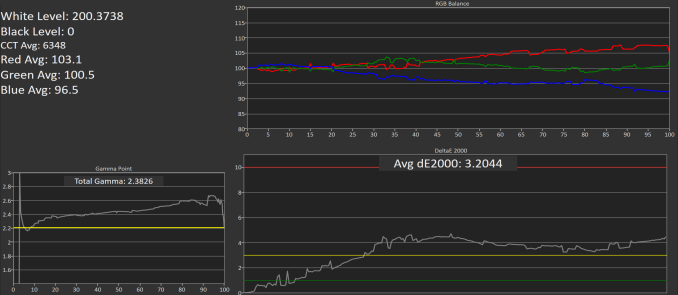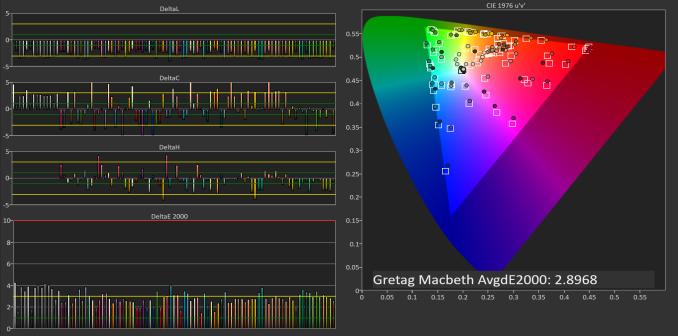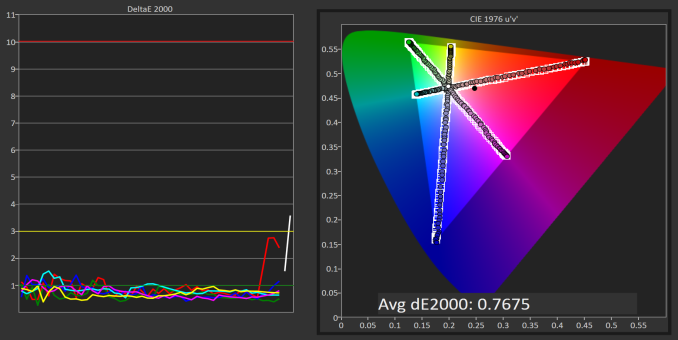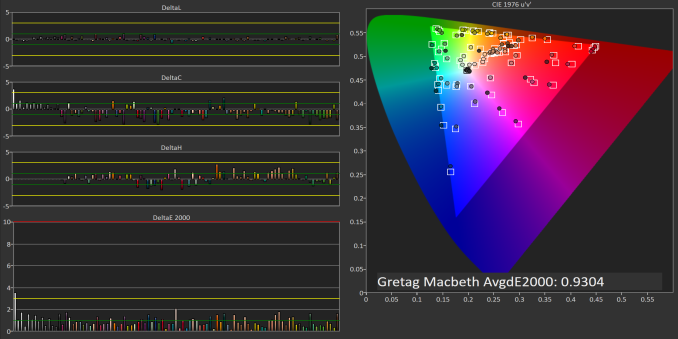The Lenovo ThinkPad X1 Yoga Review: OLED and LCD Tested
by Brett Howse & Brandon Chester on September 29, 2016 11:30 AM ESTDisplay Analysis
Since the Lenovo X1 Yoga OLED supports a variety of color modes, it's worth testing out some of them to see how well it meets the advertised specifications. As I mentioned before, the only way to pull off these color modes is to have an accurate profile of the display. This means that you really need to do calibration on an individual basis rather than applying a profile to a batch on the assumption that they're similar enough. When doing the transformations from the native gamut to the constrained gamut you need to know exactly what the output characteristics are or you'll end up with errors as you do the conversion based on a theoretical value for the display's output instead of an actual measured value.
Based on Lenovo offering these settings, my assumption going into this review was that each unit is individually calibrated. On top of that, the Lenovo Settings application is very specific about what you're promised as a user. The standard mode explicitly says that the gamma is 2.2, the gamut is sRGB, and the white point is D65, which is very specific and means that it should have a good RGB balance for every greyscale shade, and not just a CCT average of 6504K which is honestly a useless metric on its own. If the panel deviates too far from the specifications that Lenovo has stated, then it ends up being a case of over-promising and under-delivering, which is worse than just making the general promise of tracking closely with sRGB that most other vendors will make.
To evaluate the display performance of the Lenovo X1 Yoga OLED I've run our internal display workflow on it. Because this is a unique display, I'm evaluating it on its own, and because of the testing methodology the results technically cannot be directly compared to other laptops. For sRGB result, rather than a typical 21 point test, I've done a full 256 point test for greyscale which examines every single shade of grey that the panel can produce, and for the saturation sweep I've used 4 bit increments which is as precise as CalMAN allows you to go for that test. As for the GretagMacbeth ColorChecker, I've used the extended version of it which tests a much wider range of real-world patterns, and gives the best idea of the display's general color accuracy. For Adobe RGB and P3 testing I've used our standard workflow.
The X1 Yoga OLED's greyscale accuracy in the sRGB mode surprises me. Lenovo's settings explicitly state that this setting gives a gamma of 2.2, white point of D65, and sRGB gamut. The greyscale test concerns the first two metrics there, and Lenovo has not achieved either of them. As a user, when I'm told the gamma is 2.2, I don't expect a curve that is both somewhat irregular and much higher than 2.2. A small degree of deviation would be acceptable, but nothing beyond two or three percent, and certainly not nine percent. I would also expect the gamma to be much straighter than it is to avoid significant irregularity in the steps between shades of grey.
As for the white point, it's definitely not D65. While you can look at the CCT average for a simple value, it's more important to look at the RGB balance for each shade of grey. As you can see, it rapidly diverges past 20% grey, with the display leaning toward red, causing a warmer than expected appearance for most shades in the greyscale.
Ultimately the average DeltaE for greyscale shades is only 3.2, which is acceptable for standard image work outside of a professional setting. Lenovo's included color settings and the price of the laptop itself gave me high expectations that the display doesn't quite live up to, so I am somewhat disappointed here.
The average error for primary and secondary color saturations is about 2.9. This is again a good result, although not suitable for actual professional applications, which is true for most displays. The errors in colors are higher before the 50% saturation point, and after that they all drop below a value of 3.
Like the saturation test, the accuracy in the sRGB mode is good, but not suitable for imaging professionals that require the highest levels of accuracy. There's not really anything to complain about here, as the color accuracy will be suitable for all other applications. I do think Lenovo could really have pushed harder by doing individual calibration, which would allow for extremely high levels of accuracy in every color mode. With the X1 Yoga OLED being a rather expensive laptop I think it would have been feasible as far as cost is concerned, and it really would have set Lenovo apart from the competition. In any case, the sRGB accuracy is good as it is, and I don't think it's going to pose a problem for the laptop's target user.
sRGB Calibration
While the Lenovo X1 Yoga demonstrates good accuracy as far as Windows laptops go, I was surprised that the errors are as high as they are given the color settings that Lenovo includes. It's fairly obvious that the laptops are not individually calibrated, as you can reliably get error levels around a target value of one when calibrating every display individually. While this is not a common practice among Windows laptops, I find it questionable that you can justify batch calibration on a $1700 product with a premium display when $600 tablets and smartphones now come with displays that are individually calibrated and incredibly accurate, with a wide color gamut and a high resolution. Then again, I don't specialize in the Windows laptop market, so I don't exactly know what is feasible from a cost and supply standpoint.
To see how far the Lenovo X1 Yoga OLED can be improved, I've run CalMAN's greyscale calibration workflow on it. I used a 56 point calibration in an attempt to smooth out the gamma as much as possible, and to match the color settings claimed in the Lenovo Settings app I targeted the sRGB gamut, a power 2.2 gamma, and a white point of D65.
Greyscale accuracy improves tremendously with calibration. The error level for most shades of grey hovers around one, and with the exception of a small number of shades the error is always below two. The gamma is much straighter, with some small issues near the low and high ends of the greyscale where you can't make many adjustments. The balance of color components in each shade of grey is also improved, with blue still lacking but to a much smaller degree except near the low and high ends. With this calibration the laptop now truly follows the configuration that Lenovo advertises in the settings menu.
The average error for saturations is below one after calibration. In many cases the error cannot be percieved by the human eye, and in a very small cases you'd be able to tell if you put the color next to a reference pattern. The only anomaly is red, which has a slightly higher error near 100% saturation due to an issue with the red primary which cannot be corrected through greyscale calibration of one dimensional gamma ramps.
Like the saturation test, the average error in the Gretag-Macbeth ColorChecker test is below one. There's really nothing to complain about here, as in most cases you can't even see the error even if you display the color next to the true reference color.
After calibration the Lenovo X1 Yoga OLED provides a truly great display. Lenovo's factory calibration misses the mark as far as their advertised settings go, but a calibration of the greyscale is enough to bring the error levels down to a point where even the discerning eye of an imaging professional would not be able to see errors on the display.
There is one issue with performing greyscale calibration in this manner. As you'll see in the next section, there are differences between the greyscale accuracy in each color mode, especially when choosing a mode with a different gamma or definining a custom one. This means that your calibration only works for the specific color mode that was enabled when you did it, which means you have to manage color modes and then ICC profiles on top of those color modes, which is quite a mess. In general I expect users will not have the equipment and software to properly calibrate a display themselves, which is why I push so hard for excellent factory calibration, but it's worth mentioning for the subset of users that do their own calibration.
















84 Comments
View All Comments
overzealot - Wednesday, October 5, 2016 - link
Awesome, thanks Brett!ikjadoon - Friday, September 30, 2016 - link
I think there's a little error on battery capacity. IIRC, the OLED version actually uses a 56Wh battery, while the LCD uses 52Wh.http://www.notebookcheck.net/Lenovo-ThinkPad-X1-Yo...
So, then, the battery life for the OLED is actually even worse. :(
Lolimaster - Friday, September 30, 2016 - link
Not even my 7 years old Cowon S9 pmp shows that type of ghosting on his amoled display (pretty much zero ghosting).FXi - Saturday, October 1, 2016 - link
Interesting cross product implications from this review. Btw a very detailed review which is needed in this new type of product, kudos for not just glossing through the details but taking it head on.I note that power draw (with light screens which we knew about but good to note) being so much higher may well be a challenge to Apple going OLED. That may well cause them to implement a dark interface.
I bet Windows 10 with it's continuous approach to a dark interface may be ready for the move to OLED in more device types - though even using it you still had a severe drop in battery life.
If the gamut (which is going to be a big deal moving forward a couple years as 4k content all goes to wide gamut) had been wide on the LCD too, it would have been a fairer contrast. Wide gamut backlights on LCD's draw more power so then the comparison would have been more like to like in capability.
Often overlooked is that Nvidia (and possibly others but NV is the ones who discussed it) has for years made 10 bit wide gamut color accessible through DirectX which has supported wide gamut where the receiver (panel) could understand it. Now that would then need another culling of any actual games that have a wide gamut setting (even if invisible to the user) that activates on a wide gamut monitor, but be aware that taking advantage of wide gamut may not be restricted to just Adobe type programs. In fact the Nvidia driver has a checkbox for outputting 10 bit by force. This isn't color managed, but it begins to bridge the gap in the triple match you need of software/interface/hardware that would need to be aligned for high gamut impact.
If you'd tried a 4k HDR stream play on these devices I suspect you'd be pretty impressed at the differences.
Awesome job detecting the blur. That relates the the draw and hold driving of current panels that creates blur from the driving circuit in spite of OLED pixel draws. Yes it needs both hardware and driver level software to fix. Black frame insertion is the way to trick the brain and represents one first approach to curing this artifact. But it will come as no shock to you that the driver circuits in small devices are weak vs desktop or TV, but also that any special way of doing things now new to OLED and different from LCD is the weakest area of all. Very few houses make these kinds of chips needed for TV, fewer that can then be integrated for desktop and for mobile of laptop size, almost none. So it's going to take time and expansion of the entire market to drive new solutions as available.
Well done :)
cditty - Tuesday, October 4, 2016 - link
Easier for Apple to do OLED on the smaller screen. I'm really glad I read this article. The ghosting would have driven me crazy. I've used the FHD version of this laptop and liked it a lot (fingerprint login in particular). Makes sense to me why Apple is supposedly only using OLED on the Macbook Pro for a smaller touchpad. They won't trade off battery life. With processor and SSD technology constant now, it seems like the display (on a laptop) is the next battle point. I'm still relatively happy on a 5.5 inch phone with a 1080 screen. It's worth the extra battery life to me. A killer, accurate 1080 screen is better (to me) than a Q or UHD screen that kills the battery.I apologize for my 'all over the place' intermingling of phone and laptop discussion.
Erin Adreno - Sunday, October 2, 2016 - link
The nvme ssd speed doesn't seem right. That speed should come from a 950 pro instead of pm951.cptcolo - Saturday, November 12, 2016 - link
I am pretty sure it is a PM961 not a PM951cptcolo - Saturday, November 12, 2016 - link
I took apart mine, it indeed has a Samsung PM961 1TB SSD. I ordered mine back in June 2016.Ro_Ja - Monday, October 3, 2016 - link
It's also a good thing this laptop has the RAM in dual-channel mode. It greatly affects performance for onboard GPUs.amosbatto - Wednesday, October 5, 2016 - link
Let's talk about the longevity of this device. How hard is it to open the case and replace the parts? You didn't even bother to mention in the review that the battery is sealed in the case, which is very important when it dies after 2 years of use. Is it soldered or glued inside, or is it designed to be replaced? Is the keyboard a user replaceable part? Is the RAM soldered on the motherboard? Does the SSD use a standard connector? This is the essential information that determines whether a laptop lasts 5 years or 2 years and it is never included in any review.I just bought a Thinkpad T450s and I replaced the screen and added more RAM. The lid of the T450s is too thin to protect the screen in a fall in my opinion. The case is extremely hard to open without a plastic spudger and I marred the plastic because I only had a flat-head screw driver. Reviews used to open up laptops, but now we seem to live in a world where every device is designed for planned obsolescence.
These are important questions because the fabrication of a new laptop emits between 200 and 400 kg of CO2-equivalent. Between 60%-80% of the total energy of a laptop lies in its initial fabrication and the majority of its greenhouse gas emissions and other types of pollution are also caused by the fabrication. The best way to reduce the environmental impact is to use a device as long as possible and avoid new fabrication. I would appreciate reviews which at least give me some idea of the longevity of a device.
Another think that I would appreciate is some mention of the environmental hazards of its contents. Does it use PVC plastic and phthalates? Does it contain brominated flame retardants in the casing and motherboard? Does the screen contain arsenic? Does the manufacturer have a take-back policy, so the device can be easily recycled? For me, these are far more important questions when I buy a laptop than whether this device scores 5% better on some CPU test. I will never notice the incremental difference in the speed of the CPU, but I care whether I am being exposed to chemicals that may effect my hormones and could give my child a birth defect. Why do review sites like Anandtech never talk about whether the power cord on a laptop contains phthalates or not?